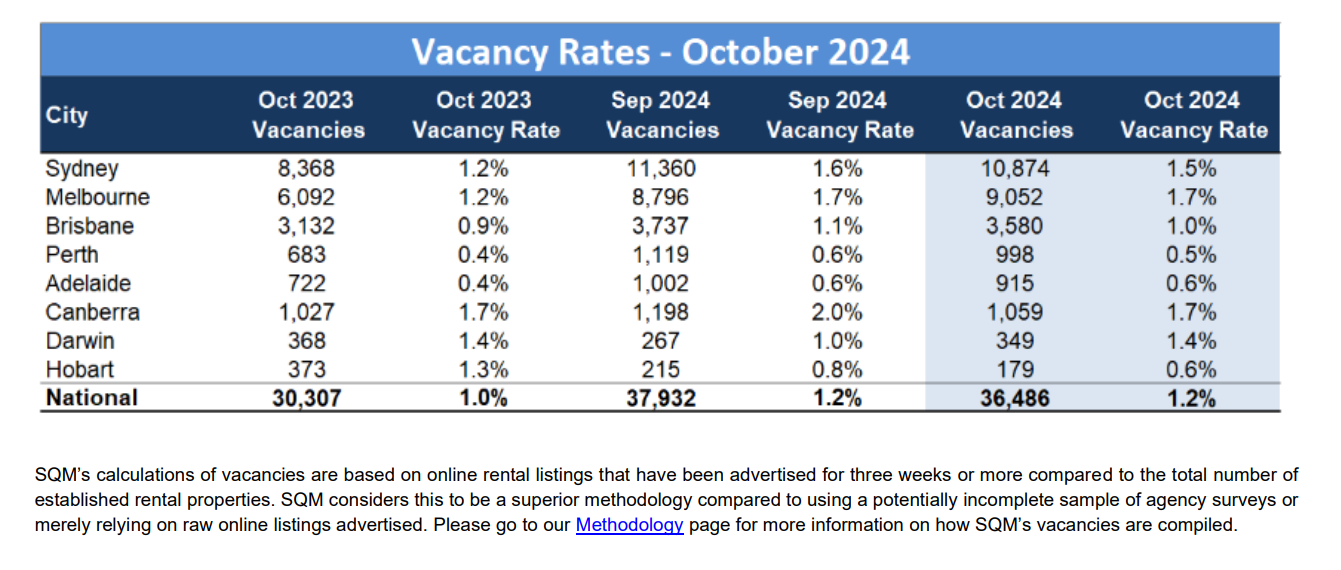

Australia’s residential rental market maintained its low vacancy rate of 1.2% in October, according to data from SQM Research.
The total number of vacant rental properties declined slightly from 37,932 in September to 36,486, with Adelaide, Perth, and Hobart showing the most significant drops.
Other cities largely remained stable or saw minor changes, reflecting the demand dynamics across Australia’s diverse rental markets.

Sydney’s rental market saw a slight improvement, with vacancy rates easing to 1.5%, totaling 10,874 available rentals.
Melbourne’s vacancy rate stayed constant at 1.7%, with 9,052 properties available.
Canberra recorded one of the highest rates at 1.7%, although this was a minor decrease from September.
In contrast, Perth’s vacancy rate dropped further to a low 0.5%, signaling continued demand, while Darwin’s vacancy rate rose to 1.4% as it entered its seasonal slowdown during the wet season.
Adelaide and Hobart maintained low vacancy rates of 0.6%, signaling tight rental conditions.
City centers displayed subtle shifts in vacancy rates, with Sydney’s CBD rate decreasing slightly to 4.7%.
Melbourne’s CBD vacancy rose modestly from 5.1% to 5.5%, while Brisbane’s CBD continued to report a low rate of 2.3%, indicating stronger demand for inner-city housing in Brisbane than in other major cities.
Over the past month, rental prices across Australia’s capital cities showed mixed trends, based on SQM Research’s Weekly Rents Index.
Sydney’s rental prices saw a minor dip of 0.1% to $836.98, while Melbourne also declined by 0.2% to $627.09, suggesting slight cooling in demand.
Brisbane recorded a sharper 1.1% drop in rental prices to $657.29, hinting at market stabilisation following rapid growth.
In Perth, combined rents fell by 0.8% to $715.26, reflecting a cooling trend after sustained increases.
However, not all cities saw declines. Adelaide experienced a 0.8% rise to $609.18, while Canberra posted a strong 2.3% increase, reaching $655.82, and Darwin saw a significant 4.2% rise to $602.75, indicating high demand in those markets. Hobart also observed a modest rise of 0.4% to $505.32.
Nationally, rental prices rose by 0.3% on average across all capital cities.
Louis Christopher (pictured above), SQM Research’s managing director, commented on these trends, noting that the national vacancy rate dropped slightly in October, though the decline was less than anticipated.
“The market has now reached its seasonal bottom on about 6,500 more rental vacancies than recorded this time last year,” Christopher said.
Looking ahead, Christopher expects vacancies to increase in November and December as university students finish semesters and holiday-related shifts affect demand.
He forecasts that advertised rents may ease, with the annual rental increase for 2024 expected to range between 3% and 4%, marking the slowest growth rate since 2020.
Get the hottest and freshest mortgage news delivered right into your inbox. Subscribe now to our FREE daily newsletter.
